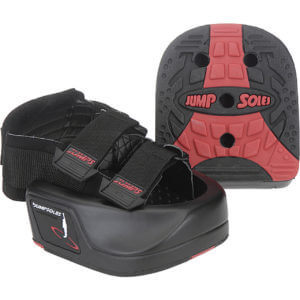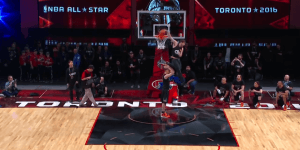I'm going out on a limb and guess that at least 99% of all basketball players out there dream of being able to dunk. I know I did!
And the good news are: this is a totally achievable goal for most people (unless you are much smaller than 6 feet) thanks to some very good training methods available today.
Unfortunately, the market for vertical jump programs is very intransparent and full of overly salesy promises and scammy-looking websites.
So which program should you trust? In this post I'll try to bring some light to the matter and make it easier for you to pick the program that is best for you!
Overview of the most well-known vertical jump training programs:
- Intense 8-week training focused on explosiveness and plyometrics
- No gym required and exercises are easy to learn
- Shows first results very quickly
- 12-week training focused on strength and power
- You learn a lot about vertical jump theory and training
- Recommended when you have weightlifting experience and access to a gym
- Up to 7 months long program
- Includes a ton of scientific information
- Creator Shawn Myszka is a highly regarded athletic coach
- 12 week training with 4-5 workouts per week
- Created by professional dunker Jordan Kilganon
- Only for experienced athletes due to heavy weightlifting
- Very old vertical jump program that doesn't hold up to todays science
- Insane workout volume towards the end of the program
- Not a very efficient way to work on your vertical jump
- Focus on calf muscles does not make sense
- Was very popular in the 90's but training concept is out of date
- Unnecessary injury risk
How Does Vertical Jump Training work?
Your vertical jump height is mostly determined by what sports science calls "Power".
Power is often confused with strength, but it's not the same thing! In the context of a vertical jump, it defines the amount of force you are able to generate during the jump itself.
It doesn't do you any good if you are the strongest person in the world if it takes you seconds to "activate" this strength. You need to be able to put as much force as possible into the ground within the blink of an eye. Thankfully, this is a skill that can be trained by using a training method called "plyometrics".
But that's not to say that you don't require strength at all. A good vertical jump training program will make sure that you improve your lower body strength but also teach you how to use this new strength in an explosive matter.
Other factors that impact your vertical jump height:
Skill and Technique:
The vertical jump is a complex movement that requires a lot of skill that can only be acquired through countless repetitions. And having to dribble and gather a ball while jumping just makes it even harder!
Flexibility:
Very stiff tendons and muscles can be an additional obstacle to jumping high. You want to makes sure you are loose and stretched (especially in the hip flexors) if you want to maximize your hops!
Which training is a good fit for me?
Not every workout is a fit for every athlete. Make sure to pick one that fits you!
If you don't have access to a gym make sure to pick a program like Vert Shock that can be done without a lot of equipment.
Also take a look at the schedule (and length) of the workouts. Some are more easily integrated into a busy life while others take a lot of time and determination.
If you are a slower (or older) but more powerful two foot jumper (think Dwight Howard), programs that focus more on strength and less on plyometrics like the Jump Manual make sense.
On the other hand, bouncy one foot jumpers (think Zach LaVine) should focus on plyometrics (e.g Vert Shock) and less on achieving crazy weights doing deep squats.
6 Vertical Jump Training Programs
Vert Shock
Duration: 8 weeks
# of workouts: 4 to 6 per week (41 in 8 weeks)
Length of workouts: <60 min
Vert Shock is an intense 8-week workout that focuses on explosive plyometric exercises and bodyweight strength training. The workouts are presented in short, high-quality videos accompanied by worksheets that tell you exactly what to do.
Rating:starstarstarstarstar_half(4.5 / 5 stars)
In my opinion, Vert Shock is the best vertical jump training program available. The plyometric exercises are easy to learn, fun, super effective, and had me dunking within 4 weeks. If you want to improve your vertical jump, this is the way to go!
Jump Manual
Duration: 12 weeks
# of workouts: 5 per week
Length of workouts: 60 -120 min
Jump Manual is a comprehensive 12-week program that mixes weightlifting and plyometric exercises with stretching, technique workouts and even a dieting plan.
Rating:starstarstarstarstar_border(4 / 5 stars)
Jump Manual was developed in 2008 and it shows. It is no longer cutting edge, but it still works!
If you want a program that focuses on strength then this is the perfect program for you!
Boing Vert
Duration: Up to 27 weeks
# of workouts: 3 to 4 per week
BoingVert is a vertical jump training program that’s made up out of two separate programs: "Animal" a 16-week long program that focuses on plyometrics and "Monster" which is an 11-week long program that is more dedicated to weight-training.
The programs where created by Shawn Myszka a well regarded certified trainer who is known for working with NFL players on their strength and explosiveness and Kelly Baggett the author of the legendary Vertical Jump Bible.
Rating:starstarstarstar_halfstar_border(3.5 / 5 stars)
It's clear that there is a lot of gold hidden in BoingVert! But overall it's just not a very well thought out program. It's too complex (and too long) for most athletes to follow and the presentation should be much more streamlined and user friendly than it is.
If you are a more experienced athlete, and you are interested in a more theoretic understanding of vertical jump training, there is a lot of knowledge here. But you'll have to put a lot of work in to reap the rewards.
BounceKit
Duration: 12 weeks
# of workouts: 4 to 5 per week
Length of workouts: up to 2 hours
Created by professional dunker Jordan Kilganon, this 12-week program features a mix of weight training, core workouts, plyometrics, and exercises that focus on increasing power.
It is split into three 4-week programs that begin with an emphasis on strength training and slowly move to more explosive exercises and plyometrics.
Lack of information, scientific background and credibility
Rating:starstarstarstar_borderstar_border(3 / 5 stars)
As we all witnessed during the 2016 All Star Game, Jordan Kilganon is without a doubt one of the best dunkers in the world. But, unfortunately, that doesn't automatically make him one of the best vertical jump trainers in the world.
While the program covers all bases, it suffers from a lack of clear vision and unnecessary complexity. If you are just getting started with working on your vertical jump, the heavy weightlifting workouts and complex power exercises are too challenging and pose a huge injury risk.
However, if you are a more experienced athlete and you can fill in the gaps of the program, you might be able to reap the benefits of the BounceKit.
Air Alert
Duration: 15 weeks
# of workouts: 3 per week (41 in 8 weeks)
Length of workouts: 270 - 3600 jumps per workout (increasing week by week)
Air Alert was one of the first vertical jump programs on the internet and has gained a lot popularity because of it. The exercises are all very simple and easy to do. But instead of increasing intensity of the exercises along the program, Air Alert just increases the volume of exercises. By week 15 you will be doing 2600!!! jumps per workout.
This philosophy does not hold up by modern scientific standards and is just straight up outdated, inefficient, and might even be dangerous because it leads to overtraining and increased injury risk.
Rating:starstar_halfstar_borderstar_borderstar_border(1.5 / 5 stars)
The program is available for free, however, I still wouldn’t recommend Air Alert because of the outdated training philosophy and presentation.
Jump Soles
Jumpsoles are a simple rubber platform you attach to your own shoes. They make it impossible to touch the ground with the heels thereby increasing the workload of the calf muscles.
They come with an 8-week training program of specific plyometric exercises like skipping, fast two-footed jumps (like lateral cone hops), and slower, two-footed jumps (like box jumps).
Rating:starstar_borderstar_borderstar_borderstar_border(1 / 5 stars)
The exercises of the workout plan that come with the Jump Soles make sense, but the product itself is a potentially dangerous and useless gimmick that you should avoid.
Conclusion
Overall I would give a recommendation to two programs:
Pick Vert Shock if you are looking for a program that will bring quick results, is easy to follow, proven to be successful.
If you are looking for a more advanced program that requires gym access and more experience with heavy weightlifting and you can tolerate an outdated presentation I would give the Jump Manual a chance.


















A little bonus for the readers that made it to the comment section:
How to get the best of both worlds!
Want to go really crazy and get every last inch out of your vertical jump?
If you have access to a gym and you are familiar with weightlifting exercises or you have a good coach I would recommend the following:
At the beginning of the offseason start a weightlifting regime. There are many good ones, but this can be very simple. For example, you could squat, deadlift and bench press 2 times a week. This way you will lay a really decent foundation by improving your strength.
Then, about 10 weeks before you want to max out your vertical jump (the start of the season), you start Vert Shock and stop working out in the Gym. The strength foundation will help you to get even more out of Vert Shock!
If you have any questions please post them in the comments. I will answer them as soon as possible!
Hi!
Great and really helpful comparison. And by the way your blog is really inspiring. So keep up the good work 😉
Have you try that Complex training techniques program at Vert Shock? Are those excersies similar to Jump Manual basic excersies?
HI Mikko, thanks! No, I haven’t tried the complex training workouts of Vert Shock. I actually totally forgot about them in this comparison 🙁 I will have to add another paragraph! These exercises do feature weightlifting exercises that are similar to Jump Manual.
hola andy,felicitaciones por tus comentarios,una pregunta ¿es conveniente durante la realizacion del programa vertical shoock o jump manual jugar baloncesto 3 dias a la semana?lunes miercoles y viernes?
I think in both cases I would spread out the training a bit more. For example to the 8 week Vert Shock in 12 weeks instead. You will need some time to rest in order to avoid injuries and overtraining!
Hi Andy. I wanted to chip in with my experience as I have used both of these programs in the recent past. I agree with your assessment that VertShock is the ideal option for beginners. The plyo work does a great job of training your muscles and tendons to fire faster and gain explosiveness. That being said, I had a better experience with The Jump Manual, and it is probably because I wasn’t a beginner.
As a former college athlete, I’d spent many years working on explosiveness and agility. I had reached a plateau with plyo work, such as VertShock. When I picked up The Jump Manual, I saw about a 7 inch improvement in the first two months after stagnating for years. I think his JA technique in the squats is a pivotal piece of the program.
In short, I think both of these programs are useful and even complementary in the long run. There is no reason why you can’t add to the Force and the Speed in your equation to improve your leap. My recommendation would be starting on VertShock and, when you reach a plateau, move over to The Jump Manual and squeeze out another handful of inches.
Thanks for the write up!
Andy,
Thanks for having the site put together those shoe reviews. Just checked out a couple and ordered a few pairs of shoes based on the ratings. I’ll report back once I’ve tried them out in the next few weeks. Also, very interested in the Vert Shock program you talk about. I play both basketball and Ultimate Frisbee, and both could benefit from increased quickness and leaping ability. Are you still keeping up with it?
Thanks again for the great site.
Cheers,
Will
Hi Will, great to hear that you like the Shoe reviews, let me know how the shoes work out. Also, if you have any suggestions let me know, I am always trying to improve this part of the site.
I haven’t done Vert Shock in a while, but I would really like to get back to it.I really was in the best basketball shape of my life two years ago when I did it. I am sure Vert Shock will help your explosiveness a lot!
Hi. After doing this for two weeks i cant touch the rim anymore and i have a lower back pain. Is this gonna last forever?
Hi Mehdi, this is can happen if your body isn’t used to workouts like that. It might be a good idea to take a few days off and give your body the rest it craves.
Hi I am 5;9 and have a 34-36 inch Max vert I am a 1 footed jumper I have once done vert shock for 4 weeks and it increased my vert by at least 3-4 inches should I start from all over again or from where I left??
Depends on how long it has been since you stopped Vert Shock. I’d say start from the beginning if it’s been more than 2 months.